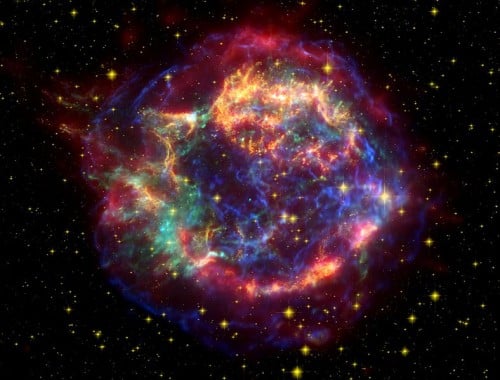A series of supernova explosions near the solar system showering the Earth with radioactive materials 1.7-3.2 million years ago. Among the researchers is Prof. Michael Paul from the Hebrew University

An international team of scientists has found evidence of a series of massive supernova explosions near our solar system that showered Earth with radioactive debris. The international team also includes Prof. Michael Paul from the Rakeh Institute of Physics at the Hebrew University.
The scientists discovered the isotope iron-60 which is a radioactive isotope in sediment and crust samples from the Pacific, Atlantic and Indian oceans.
The lifetime of iron-60 ranges from 1.7 to 3.2 million years, and its discovery shows that it is a relatively new material in astronomical terms. Says the main researcher in the study, Dr. Anton Wallner from the Australian National University (ANU).
"We were very surprised to find debris that was clearly distributed over 1.5 million years ago," said Dr Wellner, a nuclear physicist at the Australian National University's School of Physics and Engineering Research. "The discovery indicates the occurrence of a series of supernovae, one after the other.
"In an interesting coincidence, the discovery corresponds to the cooling of the earth in the transition from the Pliocene into the Pleistocene period."
The researchers discovered evidence of the Earth being showered with iron-60 from an older, eight-million-year-old supernova that occurred simultaneously with changes in vegetation around the world during the late Miocene.
Some argue that cosmic rays from supernovae increase cloud cover.
A supernova is a massive explosion of a massive star that exhausts its fuel and collapses in on itself, ejecting its mantle into space.
The scientists believe that the supernovae in this case occurred less than 300 light years from Earth, close enough to be visible during the day and were as bright as the moon.
However, although Earth was exposed to an increased bombardment of cosmic radiation, the radiation was too weak to cause direct biological damage or trigger mass extinctions.
During the explosion, the supernova produces many heavy isotopes that are scattered throughout the cosmic neighborhood. One of the isotopes is iron-60 which decays during a half-life of 2.6 million years, in contrast to the stable iron - iron 56 which has been with us since the day the earth was formed.
The iron-60 atom comes to Earth in small quantities, so the team is required to use very sensitive techniques to detect the interstellar iron atoms.
"Iron-60 from space is found in much smaller amounts than the naturally occurring iron on Earth," Dr. Wallner said.
Dr. Wallner was intrigued by the first clues to the invention of iron-60 found in samples from the bottom of the Pacific Ocean, discovered about a decade ago by a group from the Munich University of Technology.
He assembled an international team to search for interstellar dust from 120 ocean floor samples ranging in age up to 11 million years.
The first step was to extract all the iron cores from the ocean. This time-consuming task was carried out by two groups, HZDR and the University of Tokyo. The team then separated traces of the iron-60 isotope from the terrestrial isotopes using the Heavy Ion Accelerator at the Australian National University.
The age of the cores was determined by measuring the decay of other radioactive isotopes: beryllium-10 and aluminum-26, using mass spectrometry (AMS) at the various universities around the world, DREAMS in Dresden, AMS (DREAMS) of the HZDR, the Microanalysis Laboratory at the University of Tokyo and the Accelerator for Environmental Research at the University of Vienna.
The dating showed that the radioactive iron fallout appears in a relatively high concentration at two points in time - 1.7 million years ago and eight million years ago.
A possible source of the supernovae is an aging star cluster that has since moved away from the solar system. This is according to a separate study led by the Berlin University of Technology published at the same time. There are almost no large stars in this cluster, and the hypothesis is that they exploded as supernovae and threw the heavy materials into space.
to the notice of the researchers
